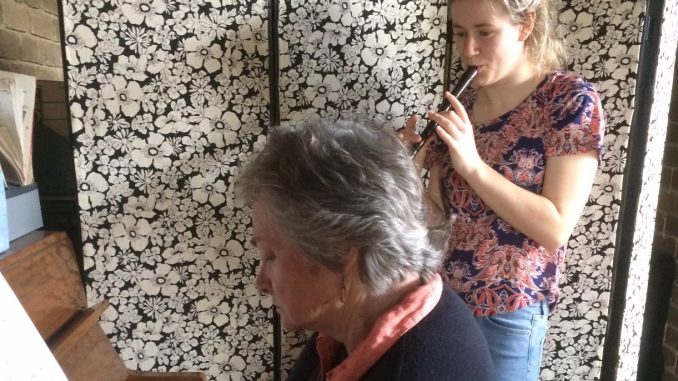
Dear Musos,
To be a piano accompanist, regular, or fill-in, for a variety of musicians, solos and ensembles, you need patience, tolerance, initiative, versatility, imagination and a long fuse. Piano-playing ability comes a long way down the list. Here’s why.
One ‘client’ was self-taught – from a book. The book didn’t have a bonus Play-along CD in the back cover. He was not musical, that is, he had no sense of melody or rhythm. Minims and quavers were all crotchets to him; he just played the notes one after the other. Rests were ignored. He said, ‘Shall I keep with you or will you go with me?’ I was tempted to say, ‘You stay with me and I’ll count.’
Page turners! Don’t have them! Those who read music are the worst because they follow the music, wait until you’ve played the very last note before carefully turning the page, taking no notice of the increasingly vigorous nodding you have been doing for several preceding bars.
Students presenting for AMEB exams usually have two rehearsals with the pianist. At my first rehearsal with a flautist, it was immediately obvious that the note values in her first phrase were not being played correctly. When this was pointed out, she insisted that that was how she played it; her teacher said so. Dilemma! If I let her go she would fail the exam for sure. I could contact the teacher and embarrass him by pointing out the error. The embarrassed teacher didn’t return the calls so I never knew what happened.
Sometimes a piece is thrust upon you on the night. There may, or may not be, time to glance at it. At some stage during the performance, you realise it is beyond you and to complicate matters, the singer loses and/or gains a beat or two here and there, so as well as struggling with the accompaniment, you have to keep adjusting to the rocky solo part.
On his way to an audition for a part in a musical, one enthusiastic but untutored tenor bought the album for the accompanist and handed it over. He launched into his song but didn’t understand that an introduction preceded the vocal line and also gave him a heads-up on the pitch of his starting note. The written key did not suit his range so it was necessary to transpose into something that would. C was close. At an audition you have the opportunity to start again, so after explaining about the introduction, I did my best to transpose the whole song into his key which wasn’t always C. (He didn’t get the part.)
We had decided not to do repeats, but in the heat of the moment, on stage, at the Seniors’ Week Concert, this is forgotten and he does a repeat but it is not the one we have just avoided; it is further back. How could I guess what would happen at the next one! We connected for the last chord. Isn’t that what counts?
Music handwritten in pencil some years ago, with indecipherable crossings and rubbings out, offers a challenge. You have to guess how many flats appear in the key signature, and as in jazz charts, the key signature does not appear on every line.
Choirs! One out of four choral conductors gives the accompanist an indication of tempo before beginning, making sure everyone observes the dynamics, brings the parts in at tricky spots and has clear cut-offs. The second of the four says at the end of the seven-page song, ‘We usually take it more slowly.’ The third waves her hands around, out and back, out and back, whatever the beat, 2, 3 or 4 in a bar. The fourth organises the choir to turn up for a performance 20k away, only to find it was the wrong day; they fumed all the way home. At the next rehearsal a secretary was appointed.
In school musicals, the lead role players are usually very good but sometimes the supporting actors need help with their songs. This might mean emphasising an unmistakeable starting note, clearly playing along with the tune but if he/she insists on going his own way, blurring and fudging some chordal stuff and, unless it’s a song of pathos, a vindicating glissando at the end. The audience will clap. Often, school musicals can rake up a small band with, of course, a drummer. One particular drummer was repeatedly asked to play more quietly because he was overpowering not only the rest of the band but the singers as well. He said that that was how he played – like it or lump it. On the last rehearsal, the stage crew brought blankets to surround and envelop the drummer. He was finally muffled. Yesss!
An operatic soprano (I hope she was chorus and not a soloist) was guest performer at an afternoon of entertainment at a Retirement Village. We had had a brief rehearsal on arriving early at the Village; some queries from me regarding some pencilled instructions on the music needed clarifying. It became obvious that she didn’t read music. We got through her piece and then an unplanned encore was to be sung. I played the introduction and started on the verse but she didn’t bother with that – it was just the chorus. Twice.
‘Consider Yourself’ from Lionel Bart’s Oliver! is in a fast 6/8, 1-and-a 2-and-a. At the choir rehearsal, we had a staggered ending. They pointed out to me that I had missed the two quaver rests a few bars from the end. They were counting 1, 2 – a whole bar in 6/8, when what was written was and-a. I made the quaver rests a pause and we all finished together.
When playing in a small jazz-type ensemble, as you approach the end of the chart, you must follow the well-known advice; if everybody else stops, you stop. Even if you have some notes left over, don’t play them.
I have not mentioned the group of lovely, talented, well-prepared and considerate people I have come across in the years of accompanying. They, including the competent choral conductor, well and truly cancel out all of the above.
If you ever find yourself in this scene, and you will because you are a muso, please learn how to pronounce accompanist – four syllables – (not accompany-ist). While you’re there, you could add the extra bonus of being sure how to spell rhythm. Then offer me a stiff drink.
With Gerald Moore
I am, as ever,
your unashamed accompanist.
* * *

